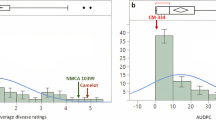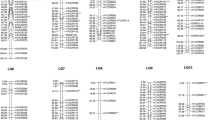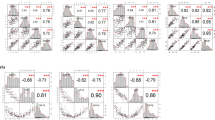Abstract
Phytophthora capsici Leonian, an oomycete pathogen, is a serious problem in pepper worldwide. Its resistance in pepper is controlled by quantitative trait loci (QTL). To detect QTL associated with P. capsici resistance, a molecular linkage map was constructed using 100 F2 individuals from a cross between Capsicum annuum ‘CM334’ and C. annuum ‘Chilsungcho’. This linkage map consisted of 202 restriction fragment length polymorphisms (RFLPs), 6 WRKYs and 1 simple sequence repeat (SSR) covering 1482.3 cM, with an average interval marker distance of 7.09 cM. QTL mapping of Phytophthora root rot and damping-off resistance was performed in F2:3 originated from a cross between resistant Mexican landrace C. annuum ‘CM334’ and susceptible Korean landrace C. annuum ‘Chilsungcho’ using composite interval mapping (CIM) analysis. Four QTL explained 66.3% of the total phenotypic variations for root rot resistance and three 44.9% for damping-off resistance. Of these QTL loci, two were located close to RFLP markers CDI25 on chromosome 5 (P5) and CT211A on P9. A bacterial artificial chromosome (BAC) library from C. annuum ‘CM334’ was screened with these two RFLP probes to obtain sequence information around the RFLP marker loci for development of PCR-based markers. CDI25 and CT211 probes identified seven and eight BAC clones, respectively. Nine positive BAC clones containing probe regions were sequenced and used for cytogenetic analysis. One single-nucleotide amplified polymorphism (SNAP) for the CDI25 locus, and two SSRs and cleaved amplified polymorphic sequence (CAPS) for CT211 were developed using sequences of the positive BAC clones. These markers will be valuable for rapid selection of genotypes and map-based cloning for resistance genes against P. capsici.







Similar content being viewed by others
References
Arumuganathan K, Earle ED (1991) Nuclear DNA content of some important plant species. Plant Mol Biol Rep 9:208–218
Barksdale TH, Papavizas GS, Johnston SA (1984) Resistance to foliar blight and crown rot of pepper caused by P. capsici. Plant Dis 65:506–509
Bartual R, Lacasa A, Marsal JI, Tello JC (1994) Epistasis in the resistance of pepper to phytophthora stem blight (P. capsici L.) and its significance in the prediction of double cross performances. Euphytica 72:149–152
Basten CJ, Zeng ZB, Wang S (2002) Windows QTL Carthographer, version 2.0. Department of Statistics; North Carolina State University, Raleigh
Bonnet J, Danan S, Boudet C, Barchi L, Sage-Palloix A, Caromel B, Palloix A, Lefebvre V (2007) Are the polygenic architectures of resistance to Phytophthora capsici and P. parasitica independent in pepper? Theor Appl Genet 115:253–264
Bosland PW (1992) Chiles: a diverse crop. Hort Technol 2:6–10
Bosland PW, Lindsey DL (1991) A seedling screen for phytophthora root rot of pepper, Capsicum annuum. Plant Dis 75:1048–1050
Collins A, Milbourne D, Ramsay L, Meyer C, Chatot-Balandras C, Overhagemann P, De Jong W, Gebhardt C, Bonnel E, Waugh R (1999) QTL for field resistance to late blight in potato are strongly correlated with maturity and vigour. Mol Breeding 5:387–398
Guerrero-Moreno A, Laborde JA (1980) Current status of pepper breeding for resistance to Phytophthora capsici in Mexico. Synopses of the IVth Eucarpia Meeting on Capsicum Wageningen (Netherlands), pp 52–56
Hong ST, Chung JE, An G, Kim SR (1998) Analysis of 176 expressed sequence tags generated from cDNA clones of hot pepper by single-pass sequencing. J Plant Biol 41:116–124
Huh JH, Kang BC, Nahm SH, Kim S, Ha KS, Lee MH, Kim BD (2001) A candidate gene approach identified phytoene synthase as the locus for mature fruit color in red pepper (Capsicum spp.). Theor Appl Genet 102:524–530
Jiang J, Gill BS, Wang GL, Ronald PC, Ward DC (1995) Metaphase and interphase Xuorescence in situ hybridization mapping of the rice genome with bacterial artificial chromosomes. Proc Natl Acad Sci USA 92:4487–4491
Kanazin V, Marex LF, Shoemaker RC (1996) Resistance gene analogs are conserved and clustered in soybean. Proc Natl Acad Sci USA 93:11746–11750
Kang BC, Nahm SH, Huh JH, Yoo HS, Yu JW, Lee MH, Kim BD (2001) An interspecific (Capsicum annuum × C. chinense) F2 linkage map in pepper using RFLP and AFLP markers. Theor Appl Genet 102:531–539
Kim YJ, Hwang BK (1989) Expression of age-related resistance in pepper plants infected with Phytophthora capsici. Plant Dis 73:745–747
Kim DS, Kim DH, Yoo JH, Kim BD (2006) Cleaved amplified polymorphic sequence and amplified fragment length polymorphism markers linked to the fertility restorer gene in chili pepper (Capsicum annuum L.). Mol Cells 21:135–140
Kim HJ, Lee HR, Han JH, Yeom SI, Harn CH, Kim BD (2008) Marker production by PCR amplification with primer pairs from conserved sequences of WRKY genes in the chili pepper. Mol Cells 25:196–204
Kimble KA, Grogan RG (1960) Resistance to Phytophthora root rot in pepper. Plant Dis Rep 44:872–873
Kosambi DD (1944) The estimation of map distance from recombination values. Ann Eugen 12:172–175
Lander ES, Green P, Abrahamson J, Barlow A, Daly MJ (1987) MAPMAKER: an interactive computer package for constructing primary genetic linkage maps of experimental and natural populations. Genomics 1:174–181
Lee JM, Nahm SH, Kim YM, Kim BD (2004) Characterization and molecular genetic mapping of microsatellite loci in pepper. Theor Appl Genet 108:619–627
Lee CJ, Yoo EY, Shin JH, Lee JM, Hwang HS, Kim BD (2005) Non-pungent Capsicum contains a deletion in the capsaicinoid synthetase gene, which allows early detection of pungency with SCAR markers. Mol Cells 19:262–267
Lefebvre V, Palloix A (1996) Both epistatic and additive effects of QTL are involved in polygenic induced resistance to disease: a case study, the interaction pepper–Phytophthora capsici Leonian. Theor Appl Genet 93:503–511
Leonian LH (1922) Stem and fruit blight of peppers caused by Phytophthora capsici. Phytopathology 12:401–408
Livingstone KD, Lackney VK, Blauth JR, Van Wijk R, Jahn MK (1999) Genome mapping in Capsicum and evolution of genome structure in the Solanaceae. Genetics 152:1183–1202
Luo MC, Thomas C, You FM, Hsiao J, Ouyang S, Buell CR, Malandro M, McGuire PE, Anderson OD, Dvorak J (2003) High-throughput fingerprinting of bacterial artificial chromosomes using the SNaPshot labeling kit and sizing of restriction fragments by capillary electrophoresis. Genomics 82:378–389
Minamiyama Y, Tsuro M, Kubo T, Hirai M (2007) QTL analysis for resistance to Phytophthora capsici in pepper using a high density SSR-based Map. Breed Sci 57:129–134
Oberhagemann P, Chatot-Balandras C, Schafer-Pregl R, Wegener D, Palomino C et al (1999) A genetic analysis of quantitative resistance to late blight in potato: towards marker-assisted selection. Mol Breed 5:399–415
Ogundiwin EA, Berke TF, Massoudi M, Black LL, Huestis G, Choi D, Lee S, Prince JP (2005) Construction of 2 intraspecific linkage maps and identification of resistance QTL for Phytophthora capsici root-rot and foliar-blight diseases of pepper (Capsicum annuum L.). Genome 48:698–711
Ortega GR, Espanol CP, Zueco JC (1992) Genetic relationships among four pepper genotypes resistant to Phytophthora capsici. Plant Breed 108:118–125
Ortega GR, Espanol CP, Zueco JC (1995) Interaction in the pepper- Phytophthora capsici system. Plant Breed 114:74–77
Park YK, Kim BD, Kim BS, Armstrong KC, Kim NS (1999) Karyotyping of the chromosomes and physical mapping of the 5S rRNA and 18S–26S rRNA gene families in five different species in Capsicum. Genes Genet Syst 74:149–157
Palloix A, Daubeze AM, Phaly T, Pochard E (1990) Breeding transgressive lines of pepper for resistance to Phytopthora capsici in a recurrent selection system. Euphytica 51:141–150
Quirin EA, Ogundiwin EA, Prince JP, Mazourek M, Briggs MO, Chlanda TS, Kim KT, Falise M, Kang BC, Jahn MM (2005) Development of sequence characterized amplified region (SCAR) primers for the detection of Phyto.5.2, a major QTL for resistance to Phytophthora capsici Leon. in pepper. Theor Appl Genet 110:605–612
Rao G, Chaim AB, Borovsky Y, Paran I (2003) Mapping of yield-related QTL in pepper in an interspecific cross of Capsicum annuum and C. frutescens. Theor Appl Genet 106:1457–1466
Reifschneider FJB, Boiteux LX, Della Bechia PT, Poulos JM, Kurada N (1992) Inheritance of adult-plant resistance to Phytophthora capsici in pepper. Euphytica 62:45–49
Ristaino JB (1990) Intraspecific variation among isolates of Phytophthora capsici from pepper and cucurbit fields in North Carolina. Phytopathology 80:1253–1259
SAS Institute Inc. (1989) SAS/STAT user’s guide. version 6, 4th edn. SAS Institute Inc., Cary
Schiex T, Gaspin C (1997) CARTHAGENE: constructing and joining maximum likelihood genetic maps. Fifth international conference on intelligent systems for Mol Biol Porto Carras, Halkidiki, Greece, pp 258–267
Smith PG, Kimble KA, Grogan RG, Millett AH (1967) Inheritance of resistance in peppers to Phytophthora root rot. Phytopathology 57:377–379
Song J, Bradeen JM, Naess SK, Raasch JA, Wielgus SM, Haberlach GT, Liu J, Kuang H, Austin-Phillips S, Buell CR, Helgeson JP, Jiang J (2003) Gene RB cloned from Solanum bulbocastanum confers broad spectrum resistance to potato late blight. PNAS 100:9128–9133
Staples RC (2004) Race nonspecific resistance for potato late blight. Trends Plant Sci 9:5–6
Sugita T, Yamaguchi K, Kinoshita T, Yuji K, Sugimura Y, Nagata R, Kawasaki S, Todoroki A (2006) QTL analysis for resistance to phytophthora blight (Phytophthora capsici Leon.) using an intraspecific double-haploid population of Capsicum annuum. Breed Sci 56:137–145
Thabuis A, Palloix A, Pflieger S, Daubeze AM, Caranta C, Lefebvre V (2003) Comparative mapping of Phytophthora resistance loci in pepper germplasm: evidence for conserved resistance loci across Solanaceae and for a large genetic diversity. Theor Appl Genet 106:1473–1485
Thabuis A, Lefebvre V, Bernard G, Daubeze AM, Phaly T, Pochard E, Palloix A (2004) Phenotypic and molecular evaluation of a recurrent selection program for a polygenic resistance to Phytophthora capsici in pepper. Theor Appl Genet 109:342–351
Walker SJ, Bosland PW (1999) Inheritance of phytophthora root rot and foliar blight resistance in pepper. J Am Soc Hort Sci 124:14–18
Wang K, Guo W, Zhang T (2007) Development of one set of chromosome-specific microsatellite-containing BACs and their physical mapping in Gossypium hirsutum L. Theor Appl Genet 115:675–682
Wenkai X, Mingliang X, Jiuren Z, Fengge W, Jiansheng L, Jingrui D (2006) Genome-wide isolation of resistance gene analogs in maize (Zea mays L.). Theor Appl Genet 113:63–72
Yi G, Lee JM, Lee S, Choi D, Kim BD (2006) Exploitation of pepper EST–SSRs and an SSR-based linkage map. Theor Appl Genet 114:113–130
Yoo EY, Kim SJ, Kim JY, Kim BD (2001) Construction and characterization of a bacterial artificial chromosome library of chili pepper. Mol Cells 12:117–120
Yoo EY, Kim S, Kim YH, Lee CJ, Kim BD (2003) Construction of a deep coverage BAC library from Capsicum annuum, ‘CM334’. Theor Appl Genet 107:540–543
Acknowledgments
This study was supported by a grant from the Center for Plant Molecular Genetics and Breeding Research (CPMGBR) through the Korea Science and Engineering Foundation (KOSEF) and Korea Ministry of Science and Technology (MOST) and a grant (20050401034791) from the BioGreen 21 Program, Rural Development Administration, Suwon, Republic of Korea.
Author information
Authors and Affiliations
Corresponding author
Additional information
Communicated by I. Paran.
H.-J. Kim and S.-H. Nahm contributed equally to this work.
Rights and permissions
About this article
Cite this article
Kim, HJ., Nahm, SH., Lee, HR. et al. BAC-derived markers converted from RFLP linked to Phytophthora capsici resistance in pepper (Capsicum annuum L.). Theor Appl Genet 118, 15–27 (2008). https://doi.org/10.1007/s00122-008-0873-5
Received:
Accepted:
Published:
Issue Date:
DOI: https://doi.org/10.1007/s00122-008-0873-5




